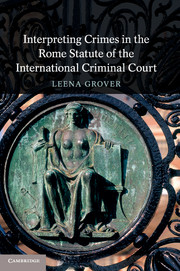Book contents
- Frontmatter
- Dedication
- Contents
- Foreword
- Acknowledgements
- 1 Introduction
- 2 The state of the art
- 3 Guiding interpretive principle
- 4 Challenges to the principle of legality
- 5 Operationalizing the principle of legality
- 6 Custom as an aid to interpretation
- 7 Internal indicia of codification
- 8 External indicia of codification
- 9 The Vienna Convention (1969) and aids to interpretation
- 10 Conclusions
- Bibliography
- Index
- References
10 - Conclusions
Published online by Cambridge University Press: 05 November 2014
- Frontmatter
- Dedication
- Contents
- Foreword
- Acknowledgements
- 1 Introduction
- 2 The state of the art
- 3 Guiding interpretive principle
- 4 Challenges to the principle of legality
- 5 Operationalizing the principle of legality
- 6 Custom as an aid to interpretation
- 7 Internal indicia of codification
- 8 External indicia of codification
- 9 The Vienna Convention (1969) and aids to interpretation
- 10 Conclusions
- Bibliography
- Index
- References
Summary
Introduction
The method of interpretation developed in this study is for crimes defined in the Rome Statute and attempts to offer its users the following levels of assistance: (1) a primary interpretive principle to guide their reasoning process when confronted with interpretive issues; (2) arguments or reasons that support (and undermine) this interpretive principle; and (3) a catalogue of materials or aids that must, may and, if applicable, may not be taken into account in support of these arguments. In this final Chapter, the methodology is summarized in the form of mandatory guidelines that are grafted onto articles 31–33 of the Vienna Convention (1969). This effort at integration is motivated by the familiarity of these articles to most readers but comes at the price of disassembling the aforementioned three tiers and their content in order to fit this into the Vienna Convention (1969) framework. To be clear, what follows is not an explanation of how articles 31–33 operate in general, but rather a summary of the relationship between these provisions and the method developed. Like the rules of interpretation in the Vienna Convention (1969), the guidelines that follow must be taken into account if relevant to a particular interpretive exercise. Where a better understanding of the impetus for or operation of a particular guideline is desired, the relevant sections of this book should be consulted.
Article 31(1) and legality
The general rule of interpretation in article 31(1) of the Vienna Convention (1969) provides: ‘A treaty shall be interpreted in good faith in accordance with the ordinary meaning to be given to the terms of the treaty in their context and in the light of its object and purpose.’ This rule, specifically the requirement of ‘good faith’, is to be read in light of legality in article 22 of the Rome Statute serving as the guiding interpretive principle for crimes defined therein. The result is that textual primacy and coherence – as opposed to drafters’ intent or object and purpose approaches to interpretation – are imperative to ensuring that the law is not applied retroactively to persons investigated, prosecuted or convicted.
- Type
- Chapter
- Information
- Publisher: Cambridge University PressPrint publication year: 2014



